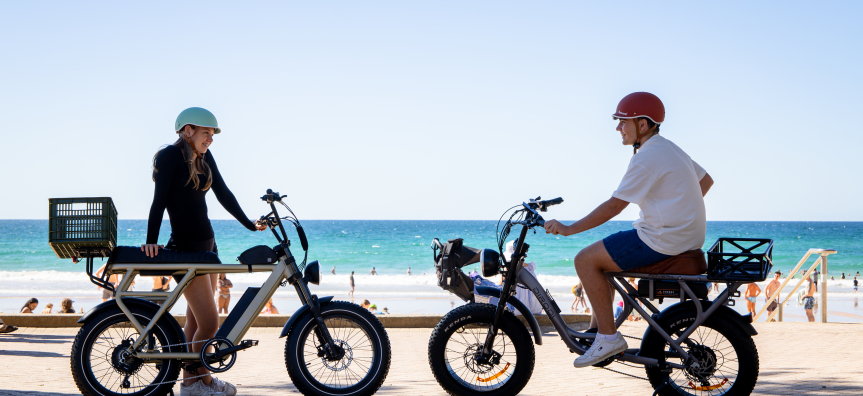E-bikes have soared in popularity on the Northern Beaches and it’s easy to see why. They are a fun and easy way to get around and they are good for our environment.
For parents navigating this new world of e-bikes, we’ve prepared this guide to help you get the facts on what is legal and sensible, and tips to help you guide your kids to keep them and everyone else safe.
1. Helmets are non-negotiable!
Helmets are not just a good idea, they are a legal requirement for all bicycle riders, including those on e-bikes. Like them or not, kids and adults need to wear them. Learn more about helmets.
2. What’s legal, and what’s not
There are 2 types of permitted e-bikes: power assisted pedal cycles and electrically power-assisted cycles (the most common in Australia).
These must be propelled primarily by the rider and cannot exceed a pedal assisted speed of 25km/hr. Modifying the speed capacity to exceed 25km/hr without pedalling makes them illegal. Doing so could land you and your child with a $723 fine for riding an unregistered device, and potentially an additional infringement for riding a vehicle without a license. Similarly the motor must have a maximum power output of 500 watts. Bike shops might not always disclose this information, so make sure you know your e-bike’s speed and motor capacity and if your child or anyone else has tampered with it.
3. Ding-ding! All bicycles need a bell
Ensure your child's bike has a bell. It's a small but essential safety feature that can prevent collisions and help alert pedestrians and other cyclists of their presence.
4. Know the e-bike code
Before your child heads out, make sure they know the e-bike code:
- Slow down to walking pace when others are on the path
- Ring your bell and call ‘on your right’ to let others know you’re approaching
- Be ready for sudden changes – people, pets and prams can be unpredictable.
5. Safe speeds in public spaces
Kids don’t always understand what ‘safe speed’ means. Emphasise to them the importance of responsible speed, especially in crowded areas like shopping districts. Pedestrians may unexpectedly step onto a path, and maintaining a safe speed can prevent accidents and promote a safer environment for everyone.
6. Liability and insurance: prepare for the unexpected
In the event of an accident, did you know that you as a parent may be held responsible for your child’s behaviour on an e-bike?
Consider looking into bicycle insurance to protect your family against potential liability issues. Bicycle NSW provides insurance to its members.
Remember, insurance is void for illegal devices, so ensure your e-bike complies with regulations.
7. Introducing your child to the road and shared paths
We recommend you implement an induction process before your child rides independently. You could go on a few supervised rides to help them safely navigate their regular routes and develop awareness of road rules and etiquette before they ride on their own, similar to teaching a learner driver!

